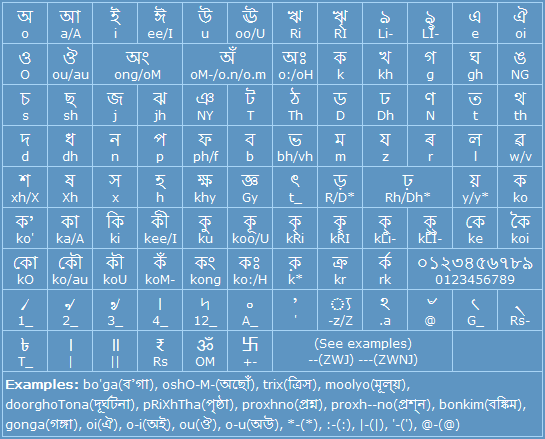Typing Dogri words using Pramukh IME is as easy as typing our names in English. For quick help, checkout the following image. This image shows which letter(s) will be typed when you press a particular key (combination). Press F9 (or your preferred Shortcut Key) to switch between currently selected language and last selected language.

Note: Typing is case-sensitive. Typing small “a” and capital “A” will yield different letters. Make sure “Caps Lock” key is not ON.
Quick Links: Vowel, Consonant, Additional Consonant, Vowel Sign, Digit, Other, Symbol, Rule, ZWJ/ZWNJ character, Example
Vowel
ऄ = a_ (Short A)
अ = a
आ = aa/A
इ = i
ई = ee/I
उ = u
ऊ = oo/U
ऋ = Ri
ॠ = RI
ऌ = Li-
ॡ = LI-
ऍ = E (Chandra E)
ऎ = E_ (Short E)
ए = e
ऐ = ai
ऑ = O (Chandra O)
ऒ = O_ (Short O)
ओ = o
औ = au/ou
अं = aM/a.n/a.m
Consonant
क = k
ख = kh
ग = g
घ = gh
ङ = NG
च = ch/C
छ = chh/Ch
ज = j
झ = jh/z
ञ = NY
ट = T
ठ = Th
ड = D
ढ = Dh
ण = N
त = t
थ = th
द = d
ध = dh
न = n
प = p
फ = ph/f
ब = b
भ = bh
म = m
य = y
र = r/R
ल = l
व = v/w
श = sh/S
ष = Sh
स = s
ह = h
ळ = L
क्ष = kSh/x
ज्ञ = Gy
Additional Consonant
क़ = k*/q/K
ख़ = kh*/Q/Kh
ग़ = g*/G
ज़ = j*/J
ड़ = D*
ढ़ = Dh*
ऩ = n*
फ़ = ph*/f*/F
य़ = y*/Y
ऱ = r*
ऴ = L*
Vowel Sign
ा = aa/A
ि = i
ी = ee/I
ु = u
ू = oo/U
ृ = Ri
ॄ = RI
ॢ = Li-
ॣ = LI-
ॅ = E (Chandra E)
ॆ = E_ (Short E)
े = e
ै = ai
ॉ = O (Chandra O)
ॊ = O_ (Short O)
ो = o
ौ = au/ou
ं = M/.n/.m (Anusvar)
Note: Dotted round symbol represents placeholder for consonant character
Digit
If the setting “Digit in English” is not set, Dogri and English digits are typed this way
০ = 0, ১ = 1, ২ = 2, ৩ = 3, ৪ = 4, ৫ = 5, ৬ = 6, ৭ = 7, ৮ = 8, ৯ = 9
0 = 0-, 1 = 1-, 2 = 2-, 3 = 3-, 4 = 4-, 5 = 5-, 6 = 6-, 7 = 7-, 8 = 8-, 9 = 9-
If the setting “Digit in English” is set, Dogri and English digits are typed this way
० = 0-, १ = 1-, २ = 2-, ३ = 3-, ४ = 4-, ५ = 5-, ६ = 6-, ७ = 7-, ८ = 8-, ९ = 9-
0 = 0, 1 = 1, 2 = 2, 3 = 3, 4 = 4, 5 = 5, 6 = 6, 7 = 7, 8 = 8, 9 = 9
Other
् = See example (Halant/Viram)
़ = * (Nukta)
ʼ = ‘ (Modifier letter apostrophe)
ऽ = .a (Avagrah)
॰ = @ (Devanagari abbreviation sign)
। = | (Devanagari danda)
॥ = || (Devanagari double danda)
₹ = Rs (Indian Rupee sign)
ॐ = OM (Aum)
卐 = +- (Swastika sign)
Zero Width Joiner = — (2 Dashes)
Zero Width Non Joiner = — (3 Dashes)
Note: Dotted round symbol represents placeholder for consonant character
Symbol
The English symbols [ ] { } ( ) < > – + / = ; . , ” ? ! % \ _ & $ # ~ : ^ are transliterated into the same symbols.
Symbols @ * | ‘ have special meaning. You can type this way
@ = @-
* = *-
| = |-
‘ = ‘-
These symbols will type Dogri characters first but if “-” will be followed, it will remove previously typed Dogri character and then type the symbol.
Rule
1. Consonant is followed by vowel sign character to make a live consonant.
Example
क का कि की कु कू कृ कॄ कॢ कॣ कॅ के कै कॉ को कौ कं
ka kaa ki kee ku koo kRi kRI kLi- kLI- kE ke kai kO ko kau kaM
2. Two or more consecutive consonants make consonant cluster. The last consonant takes the full form and all preceding consonants within cluster take half form
Example
नमस्कार = namaskaar
3. Special consonant cluster forms (ligature) will be automatically created if it is available in the font. Look at the examples for clarification. All possible ligatures may not be given in the example. Try typing the consonant combinations according to ligature pronounciation and it will work. For example, try typing “vidhyaa”, “viDyaa”, “vidyaa” to get the correct ligature for “dy” in “vidyaa”.
4. Character “-” is followed by consonant will be transliterated as ् (Halant/Viram)
Example
ख क्ह घ ग्ह छ च्ह झ ज्ह ठ ट्ह ढ ड्ह थ त्ह ध द्ह फ प्ह भ ब्ह श स्ह ष श्ह
kha k-ha gha g-ha chha ch-ha jha j-ha Tha T-ha Dha D-ha tha t-ha dha d-ha pha p-ha bha b-ha sha s-ha Sha S-ha
5. If two English characters are making one Dogri Vowel (i.e. ai, au), then “-” character is used to separate them into two different vowels.
Example
ऐरावत = airaavat
अइरावत = a-iraavat
ZWJ/ZWNJ character
Zero-width Joiner (ZWJ) and Zero-width non-joiner (ZWNJ) characters are used to produce alternate rendering of ligature.
1. A consonant followed by ZWJ character will produce half-formed consonant character.
Example
प्रश्न = prashn
प्रश्न = prash–n
2. A consonant followed by ZWNJ character will produce dead consonant character.
Example
प्रश्न = prashn
प्रश्न = prash—n
Example
सुज्जना = sujjanaa
र्लाना = rlaanaa
त्रै = trai
लूंद्धी = looMddhee
बʼन्न = ba’nna


